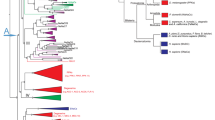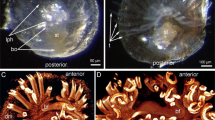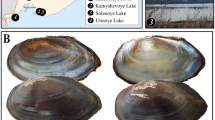Abstract
A NUMBER of electrophysiological investigations of neurosecretory neurones have been carried out in gastropod molluscs1–6 but in every case except one5 the neurosecretory status and function of the cells was uncertain. In the pulmonate snail Lymnaea stagnalis L., substantial morphological and histochemical evidence obtained by light and electron microscopy exists for regarding the ‘dark green’ (DGCs) and ‘yellow’ (YCs) neurones as neurosecretory6–8. The distinction between DGCs and YCs was based on their colour reaction to a combined Alcian blue–Alcian yellow staining technique used on sections of fixed brain material viewed under the light microscope7, but differences in elementary neurosecretory granule diameter and axon terminal location have also been found7,8. Good evidence also exists for a function of DGCs and YCs in ionic or osmotic regulation in Lymnaea; the rate of release of both DGC and YC neuroendocrine material increased when snails were kept in deionised water and decreased in hypertonic saline8–10. We show here that it is possible to identify DGCs and YCs in electrophysiological experiments and characterise them on the basis of their location, appearance and electrical properties in the live brain.
This is a preview of subscription content, access via your institution
Access options
Subscribe to this journal
Receive 51 print issues and online access
$199.00 per year
only $3.90 per issue
Buy this article
- Purchase on Springer Link
- Instant access to full article PDF
Prices may be subject to local taxes which are calculated during checkout
Similar content being viewed by others
References
Coggeshall, R. E., Kandel, E. R., Kupfermann, I., and Waziri, R., J. Cell Biol., 31, 363–368 (1966).
Gainer, H., Brain Res., 39, 403–418 (1972).
Jahan-Parvar, B., Smith, M., and von Baumgarten, R., Am. J. Physiol., 216, 1246–1257 (1969).
Junge, D., and Stephens, C. L., J. Physiol., Lond., 235, 155–181 (1973).
Kupfermann, I., Am. Zool., 12, 513–519 (1972).
Lever, J., Kok, M., Meuleman, E. A., and Joosse, J., Kon. Neder. Akad. v. Weten. Amsterdam, Ser. C., 64, 640–647 (1961).
Wendelaar Bonga, S. E., Z. Zellforsch., 108, 190–224 (1970).
Wendelaar Bonga, S. E., Neth. J. Zool., 21, 127–158 (1971).
Roubos, E. W., Z. Zellforsch., 146, 177–205 (1973).
Wendelaar Bonga, S. E., Gen. comp. Endocr. Suppl., 3, 308–316 (1972).
Stretton, A. O. W., and Kravitz, E. A., Science, 162, 132–134 (1968).
Benjamin, P. R., and Walker, T. S., Comp. Biochem. Physiol., 4l B, 813–821 (1972).
Joosse, J., Arch. Néerl. Zool., 16, 1–103 (1964).
Author information
Authors and Affiliations
Rights and permissions
About this article
Cite this article
BENJAMIN, P., SWINDALE, N. Electrical properties of ‘dark green’ and ‘yellow’ neurosecretory cells in the snail Lymnaea stagnalis L.. Nature 258, 622–623 (1975). https://doi.org/10.1038/258622a0
Received:
Accepted:
Published:
Issue Date:
DOI: https://doi.org/10.1038/258622a0
This article is cited by
Comments
By submitting a comment you agree to abide by our Terms and Community Guidelines. If you find something abusive or that does not comply with our terms or guidelines please flag it as inappropriate.



